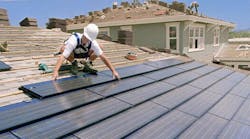A new McKinsey & Co. article, "The disruptive potential of solar power," points out that global solar installations have continued to increase by 50% a year, even while the technology is getting hit hard by cheap natural gas, an end of subsidies from governments, the financial crisis, and the flood of cheap photovoltaic panels from China that bankrupted a number of panel manufacturers. The technology, McKinsey & Co. says, will be disruptive, especially for electric utilities.
The growth of photovoltaic solar will be a problem for utilities that typically count on getting 100% of all new demand. Solar could potentially caputre half of all new demand. For perspective, for the first 10 months of 2013, 20% of all new electric demand was handled by solar.
Solar can also create problems and opportunities for contractors. A solar installation is a long-term investment, connecting the customer to the contractor for as long as 20 years.
"That combination may make solar installers natural focal points for the provision of many products and services, from security systems to mortgages to data storage, thermostats, smoke detectors, energy-information services, and other in-home products."
Plumbing, mechanical and HVAC contractors who don't want to get pushed out of their traditional markets by solar installers will have to add PV installation and service to their product offerings.


